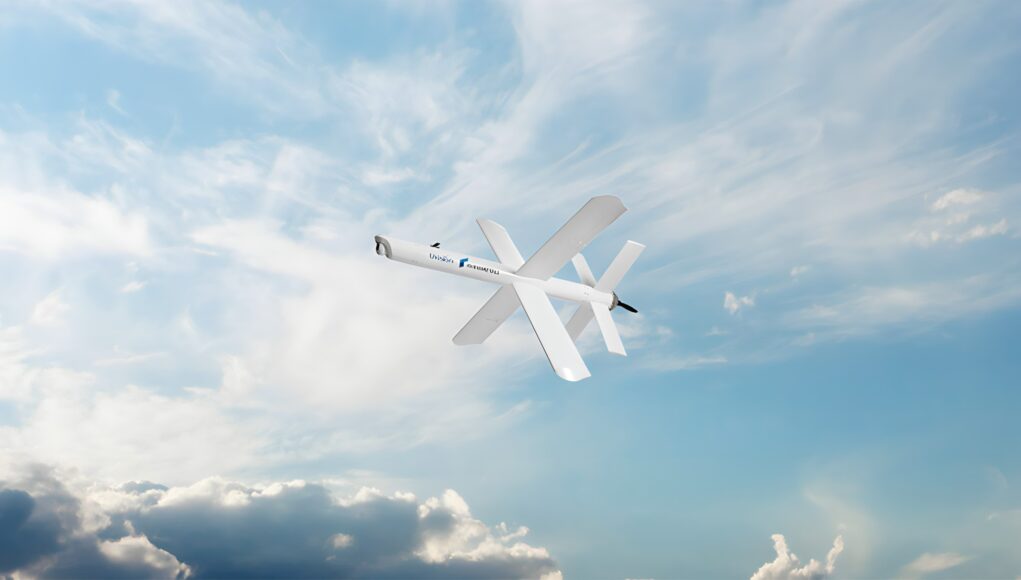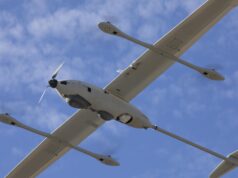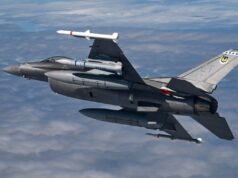Britain is seeking a ‘Medium Range Precision Strike’ system with a minimum range of 60 km, the ability to loiter in the air for at least 40 minutes and be delivered by 2027 all for a potential value of £120m.
For the avoidance of doubt, readers should be aware that the image used above is but one possible solution, and is merely used for illustrative purposes.
Today, the Ministry of Defence issued a Prior Information Notice (PIN) regarding the potential procurement of the Medium Range Precision Strike (MRPS) system, which is aimed at providing beyond-visual line of sight precision strike capability for deployed forces.
Published on 21 October 2024, the notice outlines Defence Equipment and Support’s (DE&S) plans to explore the feasibility of acquiring such a system, with the procurement process being managed by DE&S, an arm’s length body of the MOD based in Bristol.
According to the PIN, the MRPS system must meet a range of strict operational requirements, ensuring that it can perform effectively across different environments and scenarios.
a. The system must be portable by user and transportable by land, air and sea platforms with the ability to safely launch from both land and maritime platforms.
b. The system must be accurate at a minimum range of sixty-kilometres (60 km).
c. The system must be able to operate in a range of environmental and climatic conditions providing all-weather day night capability and be able to survive in a high-threat environment.
d. The system must be able to transmit real-time full-motion video at a clear standard to perform identification of the target.
e. The munition must be able to loiter for a minimum of forty minutes with a minimum average speed of one-hundred kilometres per hour (100kph).
f. The munition must be able to engage within the full range of the likely peer target sets including static and moving armour, personnel and fast inshore attack craft.
g. The munition must have a battery or warhead that is removable to enable safe charging of the system in a civilian depot.
h. The user must be able to operate the system with a capability that can, in response to real time target information, break off an engagement after initiation and then re-engage the same or different target based on user-programmed input.
i. The user must be able to utilise the system across a contested, degraded fully, GPS denied operating environment.
The MOD is planning to procure a minimum of 200 munitions, with the first deliveries anticipated by 2027. However, the PIN notes that “the information contained in this PIN may be subject to change,” and that the MOD will not be liable for any losses incurred from reliance on this early-stage information.
The MOD is also keen to engage with the market and plans to hold a Market Interest Day in late November or December 2024, to discuss the MRPS requirements in greater detail. The PIN states that DE&S will “discuss the requirement in further detail and the potential procurement routes” during the event. Organisations capable of offering the full solution, as well as those who can provide part of it, are encouraged to participate. DE&S invites organisations to “explicitly state which part of the solution your organisation can offer,” reinforcing the MOD’s openness to a range of capabilities and innovations.
It is important to note that the PIN is “not a means to seek formal expression of interest” and does not represent a commitment to initiate the formal procurement process. Interested parties are advised to register their interest through the MOD’s official procurement portal.
What is a loitering munition anyway?
A loitering munition, also known as a “kamikaze drone” or “suicide drone,” is a type of weapon system designed to hover in the air over a target area for an extended period before striking. It combines features of both drones and missiles, allowing it to search for, identify, and engage targets with precision. Once a target is identified, the munition can dive into it, detonating on impact.
Loitering munitions are equipped with sensors and communication systems to allow operators to monitor and control them in real-time. They can be deployed from land, air, or sea platforms and are particularly useful for missions requiring quick responses to emerging threats. The ability to remain airborne for a set period allows operators to wait for the optimal moment to strike, improving target accuracy and reducing collateral damage.
These systems are often used in situations where traditional missile or artillery strikes would be less effective. The loitering capability ensures that the munition can be recalled or re-targeted if the original target is no longer viable, providing more flexibility than conventional munitions. Loitering munitions are typically smaller than traditional missiles, making them easier to transport and deploy in various environments.
Loitering munitions are increasingly being integrated into modern forces due to their cost-effectiveness and precision. They are particularly effective against time-sensitive or mobile targets, such as vehicles or personnel, and are used in a range of conflict scenarios, from asymmetrical warfare to conventional military engagements.














This is why North Korea is sending soldiers to the Ukraine. Nothing to do with reinforcing the Russians. They want their troops exposed to the modern battlefield. I would love to know what the SAS/SBS are sending back into the system. They are bound to come up with some novel approaches to the drone problem.
To Ukraine, not “to the Ukraine”. Sorry to sound like a d*ck.
Your name’s not Richard. 😉
Touche sir. 😁
We spent £200m developing the Fire Shadow loitering munition before cancelling it in 2017.
sUAS News, 2010.
Portable, precision, range, loiter time, all-weather, network-centric operations capability, man in the loop. Already designed and tested. Other than the GPS denied environments, it ticks all the boxes. Warm it up and serve it hot. I wonder if it was too expensive.
After cancellation we went for the US Switchblade instead, buying in $45m worth.
Two years ago the Royal Navy was looking for POD-delivered loitering munitions and Fire Shadow was mentioned in UKDJ comment sections. So I thought now DE&S are getting in on the act, I’d bring it up again.
Was just going to mention FS but you arrived first. 👍
You snooze, you lose 😉
-Perhaps US industrial pressure.
No, British incompetence 😀
Only hundreds? Not hundreds of thousands?
Logistics, how could you store much less launch hundreds of thousands. This thing has a big bomb on the front you can just leave them in a warehouse.
The solution then is to keep several production lines going with continual redundant component refresh. A major war would need thousands. The UK purchased 900 Storm Shadow and must have thousands of HVM , MARTLET and Javelin. Surely armoury space for more than 200 is not much to ask?
Already gone over this previously but there is a fine balance between producing enough to fulfil your immediate needs and not storing rapidly deteriorating and increasingly obsolescent drones in their thousands. You need a sufficient base stock combined with being able to bring on production lines that quickly swing into producing thousands of rapidly updating products. Tbh seeing how Ukraine does it as long as you prepare the basics setting up commissionable lines for drone production like these simpler models should not take too long and not necessitating redundant lines just waiting which isn’t practical. Getting that balance right is the tough part but possible if design and development kept ongoing so should be feasible, as in the war all manner of companies should be able to produce them.
Maybe but a FPV battalion in Ukraine can spend 200 FPV’s in a day.
I know this is an higher class drone but shows what is going on.
These are serious weapons, not sprinkles for your ice cream.
Seem to remember we had one 15 years ago called Fireshadow then Dave cancelled it. Well done Dave, really punching above weight now.
Call me Dave was, is, and always will be an egotistical self-centred twat lacking in any strategic understanding or innovative thinking.
He and Blair 2 sides of the same coin.
Agreed this is a guy who studied politics became a political researcher and only got a ‘real’ job by curtesy of his wife’s dad, some qualifications to be PM that, as well shown by his total lack of ability to manage a worthwhile career since, beyond mates and opportunists giving him self serving and somewhat suspect work.
Although it was starved of funds under Cameron’s austerity, the coup de grace occurred under Theresa May’s leadership.
Indirect fires continue its path to rise in combat importance at expense of direct fires.
I would like see British buy
Infantry / Vehicle loitering Munition Weapon:-
(Light Infantry) – Hero 30 – short range – anti infantry, it is better choice over switchblade as recoverable which switchblade 300 don’t (600 can recoverable)
(Medium Infantry & Vehicle) Hero 120 – medium range and anti-tank <– see match spec what British look for.
(Heavy Vehicle) Hero 1250 – long range and heavy building attack
We should keep fire shadow loitering mutation as seem more superior due range and time loitering. (Hero 1250 is better spec as range over 300km and time loitering 12+ hours)
Reason I want hero series as they recoverable if not attack target so it is can act as recon and recoverable, and if find target to attack so able to attack.
Given the Trinity House Agreement, you might find that holding out for a Hero will actually lead to something more than Bonnie Tyler fatigue.
Thank for point it to new treats sign today new UK-germany agreement.
so one Germany company I think they does make uv vision partner (Rhem……..) product hero series.
So all these list agreement is seem interesting to see how it is go on.
Thank again 😉
I think everybody knows to turn to, (
judging by the photo…) but they are “ashamed” and go into “hiding”. Apropos,
for the Germans in Israel: – (Den Remote Carrier Eher ein wiederverwendbarer Waffenträger.) And not by 2040. https://www.twz.com/air/the-existence-of-israels-secret-stealth-drone-should-come-as-no-surprise Regards…